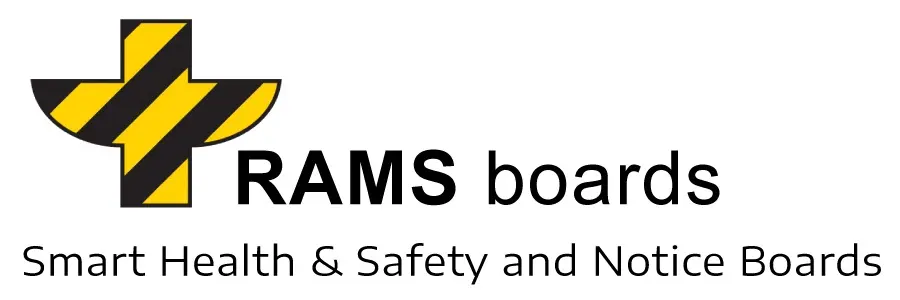Why Project Safety Noticeboards Are Essential
In high-risk environments like construction sites, safety communication is a top priority. With heavy machinery, hazardous materials, and constantly changing conditions, site managers face the challenge of keeping workers informed about potential risks and emergency procedures. Effective communication tools, such as project safety noticeboards, have become indispensable for improving safety awareness and ensuring regulatory compliance.
Project safety noticeboards act as centralized hubs for critical information. They display everything from emergency contact numbers to hazard warnings and site safety rules. By making this information easily accessible, these boards help prevent accidents and streamline response times during emergencies. Additionally, they serve as a visual reminder of safety protocols, reinforcing a culture of accountability and compliance across the workforce.
However, traditional noticeboards often fall short. Boards made from plywood and other basic materials are prone to damage from weather and site activity.
These outdated solutions can quickly become cluttered or illegible, reducing their effectiveness. Modern safety boards, like those provided by RAMS Boards, SafetyBuyer, and First Safety Signs, address these shortcomings by offering durable, customizable solutions that integrate both physical and digital features.
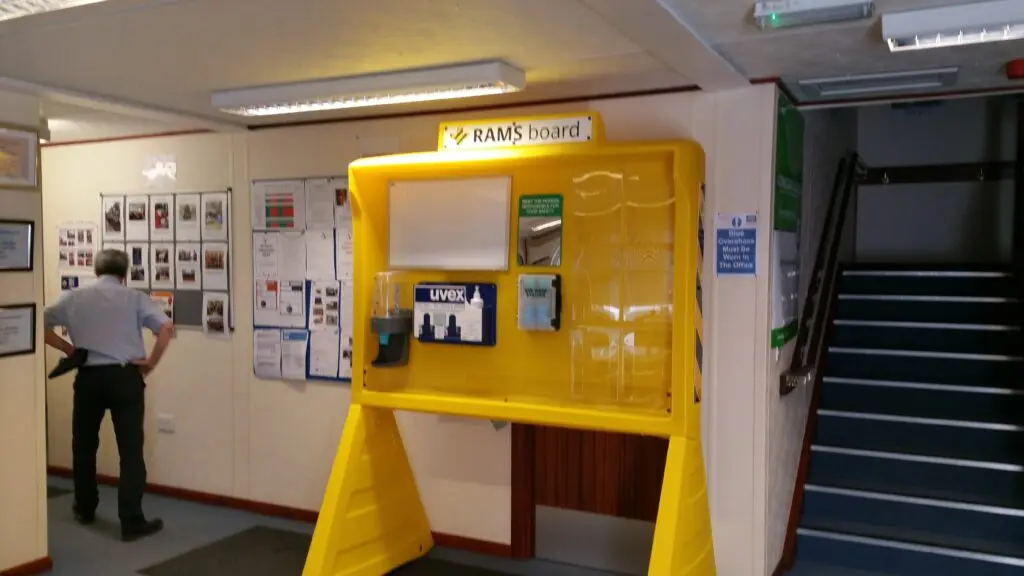
In industries where compliance with safety regulations is mandatory, project safety noticeboards are not just an option—they are a critical component of safety management. Regulatory authorities often require that essential documents, such as risk assessments and emergency plans, be clearly displayed and regularly updated. By investing in high-quality safety noticeboards, construction directors and heads of safety can ensure that these requirements are consistently met.
Types of Construction Safety Board Providers
The market for safety noticeboards is competitive, with several key providers offering solutions tailored to the needs of construction and industrial sites. These companies emphasize durability, customization, and ease of use to meet the demands of safety-critical environments.
- SafetyBuyer: This provider offers a wide range of safety boards designed to enhance on-site emergency communication. Their boards are known for integrating essential safety notices, such as evacuation plans and hazard warnings, with customizable layouts.
- First Safety Signs: Specializing in custom safety signage, First Safety Signs provides solutions that can be personalized with company logos, project-specific messages, and hazard instructions. Their boards are designed to attract attention and promote compliance through clear, visually engaging displays.
- RAMS Boards: RAMS Boards stands out for its modular, multifunctional boards constructed from high-density polyethylene (HDPE). These boards are highly durable, weather-resistant, and eco-friendly, making them ideal for dynamic work environments. With features like magnetic whiteboards, transparent document pockets, and optional safety equipment holders, RAMS Boards cater to a wide variety of safety communication needs.
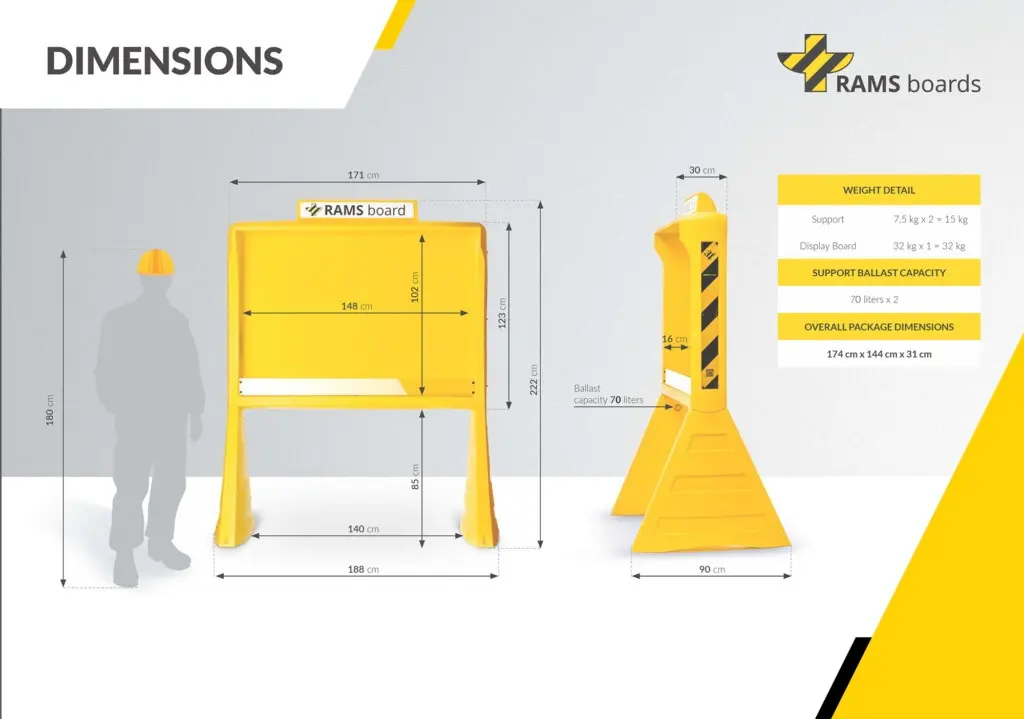
These providers offer solutions that are not only compliant with health and safety regulations but also designed to foster a stronger safety culture. By offering customization and integration with essential safety tools, these boards empower site managers to improve both safety awareness and worker engagement.
Features of Custom Safety Boards
Custom safety boards are designed to meet the specific needs of individual projects and industries. Unlike generic noticeboards, these tailored solutions allow site managers to display safety information that is both relevant and engaging to workers. Personalization options such as company logos, site-specific messages, and hazard warnings make safety boards more effective at capturing attention and reinforcing compliance.
Modern custom boards can integrate various physical and digital features to enhance their functionality. These boards are not just static displays—they serve as comprehensive safety communication tools that help organize critical documents, update information in real-time, and improve worker engagement.
1. Personalization Options
One of the most important features of custom safety boards is the ability to adapt their layout and content to the specific needs of a project or company. Examples of customization options include:
- Company Branding: Incorporating logos and colors enhances the board’s visibility and aligns with corporate identity.
- Tailored Messages: Boards can display project-specific instructions, such as safety rules for handling hazardous materials or protocols for high-risk activities.
- Custom Layouts: Depending on the type of worksite, boards can prioritize different types of information, such as evacuation procedures, inspection records, or real-time hazard alerts.
This level of customization ensures that workers encounter information that is directly relevant to their tasks, increasing the likelihood of compliance with safety protocols. Additionally, branded safety boards demonstrate a company’s commitment to safety, which can positively influence both employees and external auditors.
2. Integration with Safety Equipment
Custom safety boards can also include integrated safety equipment, making them multifunctional safety hubs. Common features found in these advanced boards include:
- Fire Extinguisher Holders: Boards can be equipped with built-in stands or brackets to ensure fire extinguishers are easily accessible.
- Eye Wash Stations: In environments where chemical exposure is a risk, having eye wash stations attached to safety boards improves response times in emergencies.
- Earplug Dispensers: To promote hearing protection, especially in noisy environments, some boards come with dispensers for ear protection gear.
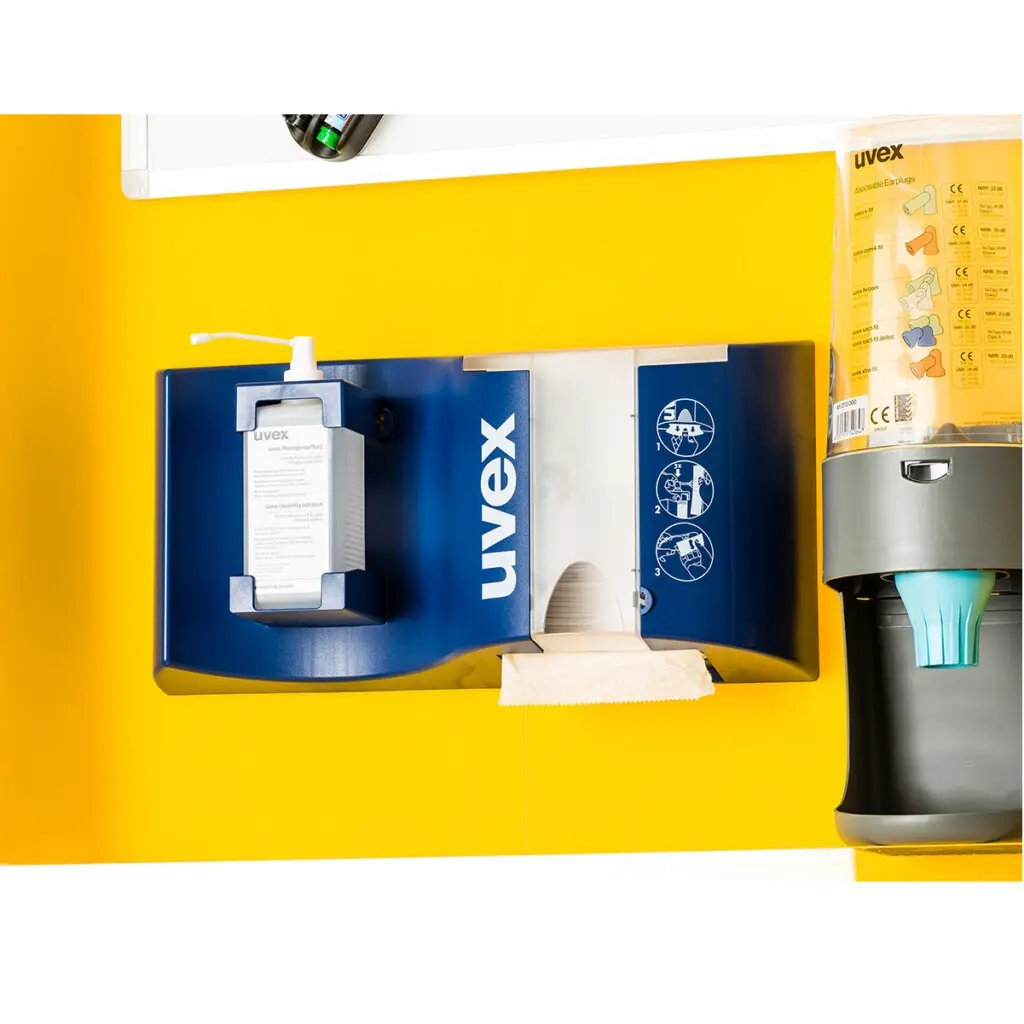
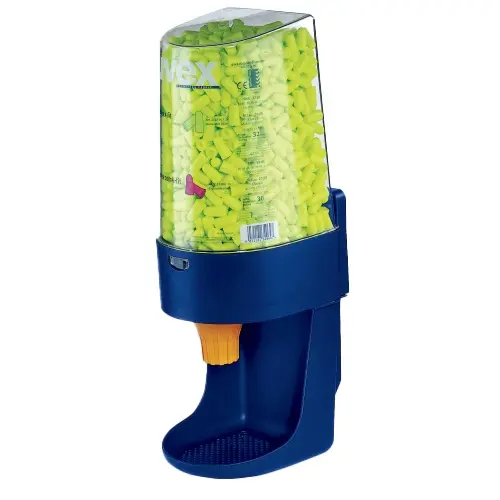
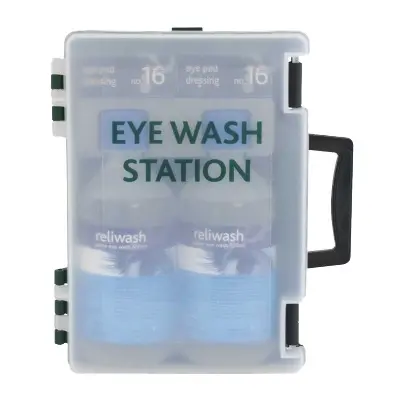
By combining essential equipment and safety information in one location, these boards reduce the time workers need to find safety resources, improving both efficiency and preparedness.
3. Document Organization and Protection
One of the most practical features of custom safety boards is the inclusion of transparent document pockets designed to organize and protect key safety documents. These durable pockets safeguard critical information from damage caused by weather, dust, or site activity. Commonly stored documents include:
- Risk Assessments: Mandatory for most construction activities, these documents outline potential hazards and the measures taken to mitigate them.
- Emergency Procedures: Clear instructions on how to respond to emergencies such as fires, injuries, or evacuations.
- Inspection Reports and Contact Lists: Keeping inspection schedules and key contact numbers visible helps workers stay informed and prepared.
By maintaining a clear and organized display of documents, custom boards improve both compliance and communication. Workers can quickly locate the information they need, reducing confusion and delays during inspections or emergencies.
4. Real-Time Updates
Custom safety boards often feature magnetic whiteboards, which allow site managers to post daily or weekly updates. This feature is particularly valuable on construction sites, where conditions and risks can change frequently due to project progress, equipment usage, or weather. Real-time updates help keep workers aware of evolving hazards and safety protocols, improving their ability to make informed decisions.
Additionally, some boards incorporate digital technology, such as QR codes or RFID tags, to provide mobile access to detailed safety procedures. Workers can scan these codes to view documents, videos, or training materials, making safety information more accessible and reducing the need for physical paperwork.
5. Design for Worker Engagement
The layout and design of custom safety boards are carefully planned to maximize engagement. Safety messages are presented in clear sections, with priority given to the most critical information, such as emergency contacts and hazard warnings. Visual aids like symbols, colors, and diagrams further enhance readability and comprehension.
Incorporating motivational elements can also influence behavior.
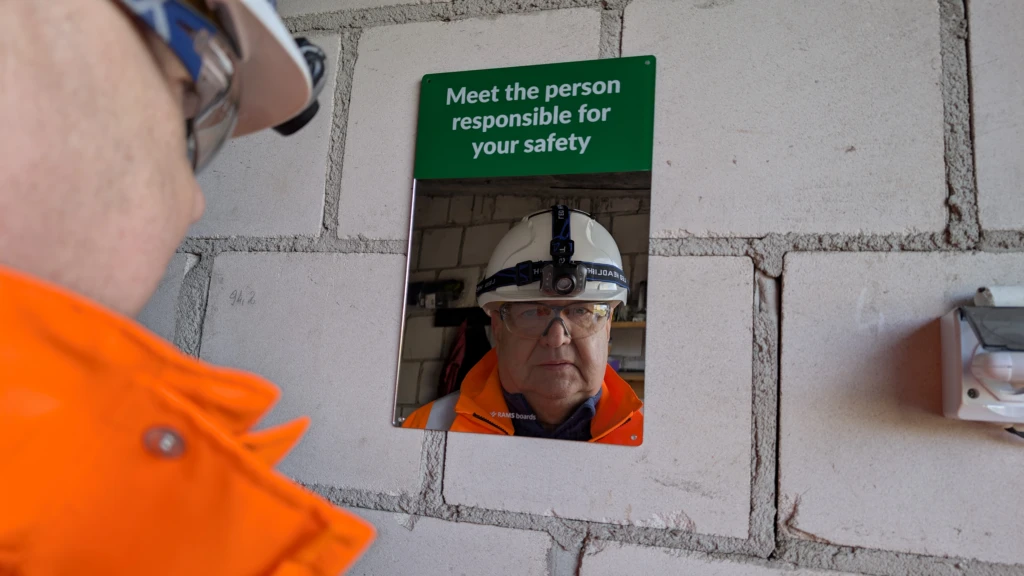
For example, RAMS Boards feature a small mirror with the message “Meet the person responsible for your safety.” This subtle reminder encourages workers to take personal responsibility for following safety protocols, contributing to a more proactive safety culture on site.
By offering extensive customization and integration options, modern safety boards help companies address the unique safety needs of their projects. These features not only improve compliance but also enhance worker engagement, making it easier for site managers to maintain a safe and productive environment.
Core Functions of Site Safety Noticeboards
Site safety noticeboards serve as centralized hubs for critical information on construction and industrial sites. Their primary purpose is to provide workers with clear, accessible, and up-to-date safety instructions, helping to reduce risks and ensure compliance with safety regulations. By organizing and displaying key documents and alerts, these boards play a crucial role in creating a safer, more efficient work environment.
Effective safety boards focus on three core functions: displaying critical safety information, organizing and protecting essential documents, and enhancing visibility for quick access during emergencies. Each of these functions contributes to better communication and worker awareness, which ultimately helps prevent accidents and costly regulatory violations.
1. Displaying Critical Safety Information
Safety noticeboards are designed to present essential information that workers need to perform their tasks safely and in compliance with regulations. The information displayed on these boards typically includes:
- Hazard Warnings: Boards highlight potential risks on the worksite, such as falling objects, high-voltage areas, or chemical exposure zones.
- Emergency Procedures: Clear, step-by-step instructions guide workers on what to do during emergencies, including fire evacuations, first aid procedures, and spill containment.
- Emergency Contact Details: Quick access to the contact information of first responders, safety officers, and medical personnel is vital in high-risk environments.
By prioritizing high-impact safety messages, these boards ensure that critical information is always visible to workers. This reduces the time spent searching for safety instructions, improving both awareness and response times during emergencies.
2. Organizing and Protecting Essential Documents
On many worksites, safety documents are legally required to be displayed at all times. Site safety noticeboards provide a dedicated space to store and protect these documents, ensuring they remain accessible and legible. Commonly displayed documents include:
- Risk Assessments and Method Statements (RAMS): These outline the risks associated with specific tasks and detail the measures taken to mitigate those risks.
- Inspection Reports: Regular inspection records help workers stay informed about site conditions, compliance status, and areas requiring corrective action.
- Construction Plans and Safety Policies: Plans detailing site layouts, work zones, and safety policies are crucial for maintaining order and reducing confusion.
The inclusion of transparent document pockets or protective covers shields paper documents from weather, dirt, and damage. This feature ensures that even in challenging outdoor conditions, important information remains visible and easy to read.
3. Enhancing Emergency Preparedness
In emergencies, quick access to safety information can prevent injuries and save lives. Safety boards are strategically placed in high-traffic areas to maximize visibility and accessibility. Workers are trained to use these boards as central reference points during drills and real emergencies, helping to streamline response efforts.
Many boards, such as those produced by RAMS Boards, include features designed to enhance emergency preparedness. These can include:
- Fire Safety Points: Some boards are equipped with stands for fire extinguishers and other fire safety equipment.
- First Aid Information: Boards may display the location of first aid kits and include instructions for basic emergency procedures.
- Evacuation Diagrams: Visual maps showing evacuation routes help workers quickly find the safest exit in case of emergencies.
By combining both static and dynamic information, site safety boards become key tools for managing emergency scenarios efficiently. Workers are better prepared to respond, and site managers can ensure that all legal and regulatory requirements are met.
4. Reinforcing Safety Compliance
Maintaining compliance with health and safety regulations is a top priority for construction directors and heads of safety. Regulatory bodies require that key safety documents be displayed in an organized and easily accessible manner. Site safety noticeboards simplify this process by providing a standardized format for presenting required information.
Inspectors often evaluate the condition and content of safety boards during audits. A well-maintained board with updated documents demonstrates a company’s commitment to safety and can lead to smoother inspections. Conversely, poorly maintained boards with missing or outdated information can result in compliance violations, fines, and increased liability risks.
Safety noticeboards also play a role in shaping behavior. When workers encounter clear, well-organized information daily, they are more likely to internalize and follow safety protocols. This contributes to a safer, more compliant workplace, reducing the likelihood of accidents and costly disruptions.
5. Dynamic Updates to Address Evolving Risks
Construction and industrial sites are dynamic environments where hazards can change rapidly. Safety boards equipped with magnetic whiteboards or digital features allow site managers to post regular updates on new risks, project milestones, or weather-related changes. This adaptability ensures that workers are always informed of the most current safety conditions, supporting a proactive approach to risk management.
By fulfilling these core functions, site safety noticeboards help site managers and EHS professionals maintain a well-organized, compliant, and safety-conscious work environment. The ability to display, protect, and update critical information in real-time makes these boards essential tools for effective communication and hazard management.
Compliance and Safety Communication Solutions
Ensuring compliance with safety regulations is a fundamental responsibility for site managers and heads of safety in industries like construction and manufacturing. Failure to comply with health and safety standards can lead to severe consequences, including legal penalties, project delays, and workplace injuries. Site safety noticeboards are integral to maintaining compliance, as they centralize essential safety information and facilitate effective communication between workers and management.
By clearly presenting required documents, emergency procedures, and hazard warnings, safety noticeboards provide site managers with a practical tool to fulfill regulatory obligations. They also serve as a visual representation of a company’s commitment to safety, improving both internal engagement and external audit outcomes.
1. Meeting Regulatory Requirements
Health and safety authorities, such as the UK Health and Safety Executive (HSE) and the U.S. Occupational Safety and Health Administration (OSHA), mandate that certain safety documents be displayed prominently on worksites. These include:
- Risk Assessments: Detailed documentation outlining potential hazards and the measures implemented to mitigate them.
- Emergency Procedures: Clear instructions on what workers should do during incidents such as fires, chemical spills, or injuries.
- Inspection Logs: Records of safety inspections that demonstrate ongoing efforts to maintain safe working conditions.
Failing to display or update these documents can result in costly fines or project shutdowns. Modern safety boards, such as those offered by RAMS Boards and SafetyBuyer, help companies stay compliant by providing durable, organized displays for legally required materials. Protective features like weatherproof document pockets prevent damage to critical paperwork, ensuring that information remains legible and accessible.
2. Centralized Communication for Hazard Management
Hazard communication is a key aspect of safety compliance. Workers must be informed of site-specific risks, including moving equipment, hazardous materials, and confined spaces. Site safety noticeboards act as centralized communication points where these hazards are clearly documented and updated as needed.
By using color-coded symbols and warning signs, boards enhance the visibility and comprehension of safety messages. For example, red sections might highlight fire safety points, while yellow areas emphasize caution zones or ongoing construction work. This structured approach makes it easier for workers to identify and respond to risks, reducing the likelihood of accidents caused by miscommunication or lack of awareness.
Additionally, safety boards can improve coordination among different teams on large projects. Subcontractors and temporary workers, who may not be familiar with the site’s layout and risks, can quickly access critical information upon arrival. This reduces onboarding time and improves overall site safety compliance.
3. Real-Time Updates to Evolving Safety Conditions
Construction and industrial sites are dynamic, with hazards that can change daily or even hourly. Safety noticeboards that incorporate magnetic whiteboards or digital features enable site managers to post real-time updates regarding new risks and safety instructions. Common updates include:
- Weather Alerts: Changes in weather conditions, such as high winds or heavy rain, can introduce new hazards that need to be communicated immediately.
- Equipment Movement: Notices regarding the relocation of heavy machinery or crane operations help prevent collisions and other site incidents.
- Safety Drill Announcements: Regular drills are a regulatory requirement on many sites. Posting schedules and procedures on safety boards ensures all workers are informed and prepared.
By allowing for frequent updates, these boards support dynamic risk management and help site managers maintain a high level of awareness and compliance across the workforce.
4. Streamlined Inspections and Audits
Compliance inspections are a routine part of operations on regulated sites. Inspectors often evaluate the condition and content of safety noticeboards to verify that key information is displayed accurately and consistently. Boards that are well-maintained, with properly organized and updated documents, can simplify the inspection process and demonstrate that a company takes its safety obligations seriously.
Conversely, outdated or poorly organized boards may trigger compliance violations and further scrutiny. For example, missing risk assessments or unreadable emergency plans can be grounds for immediate penalties. By investing in high-quality safety boards with customizable layouts, companies can reduce the risk of non-compliance and foster a positive relationship with regulatory bodies.
5. Encouraging Worker Accountability
Compliance is not just about meeting legal standards—it also depends on worker participation. Safety noticeboards help reinforce a culture of accountability by making safety information highly visible and easy to understand. When workers see regularly updated hazard warnings and clear emergency procedures, they are more likely to follow protocols and take precautions.
Design elements such as motivational messages and personal responsibility reminders further encourage engagement. For example, a simple message like “Your safety starts with you” positioned near the board’s central area can influence behavior and promote a proactive approach to safety.
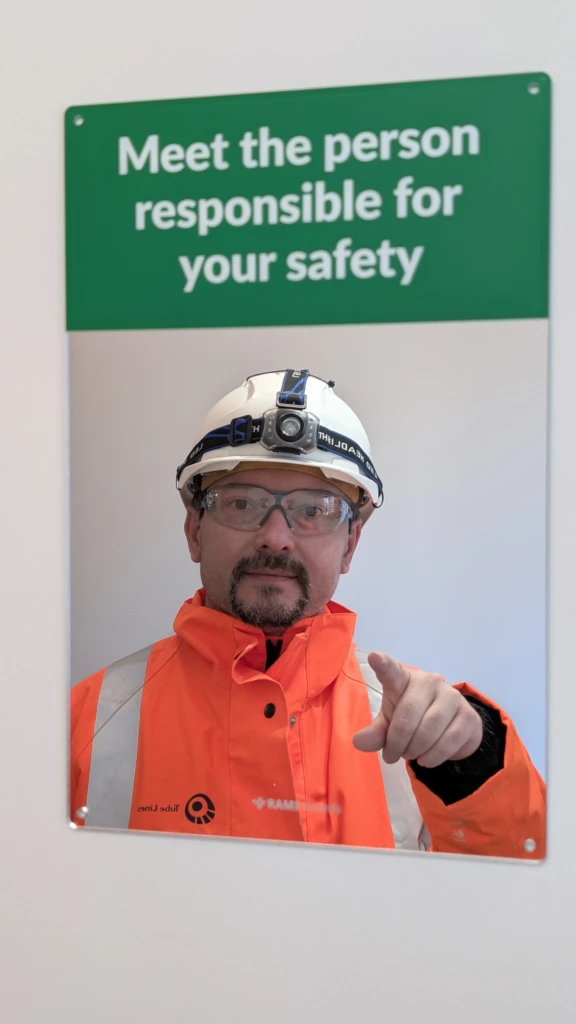
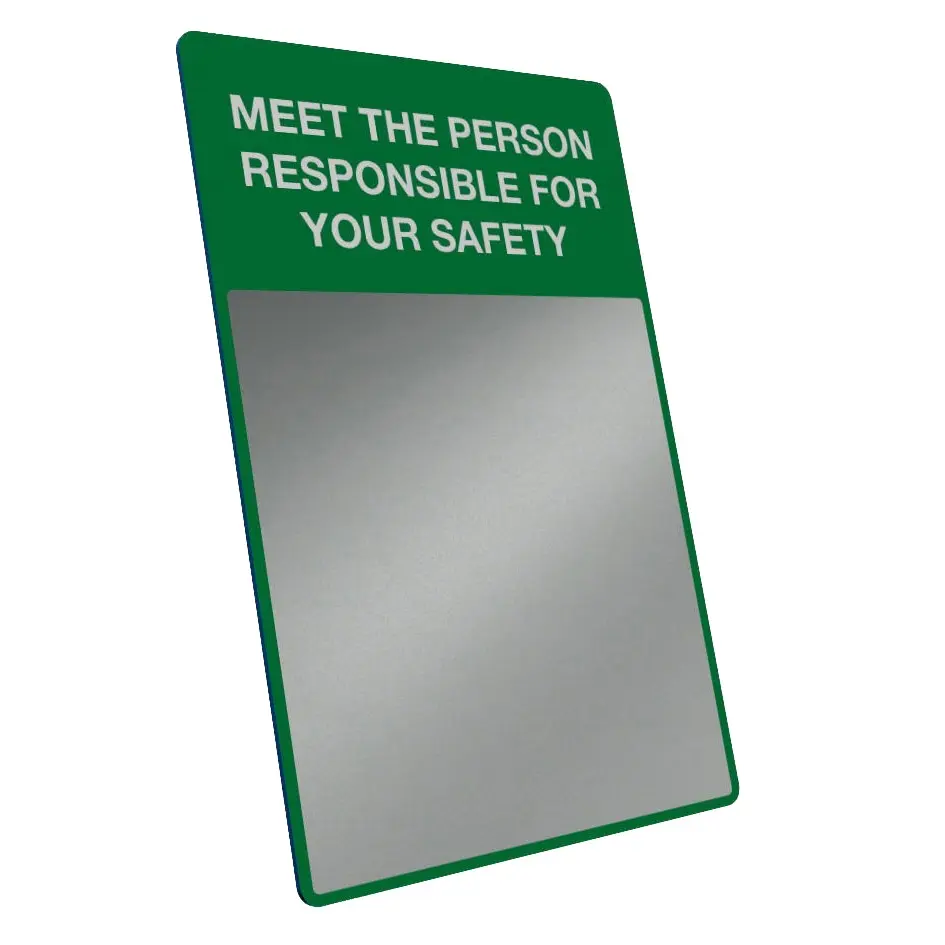
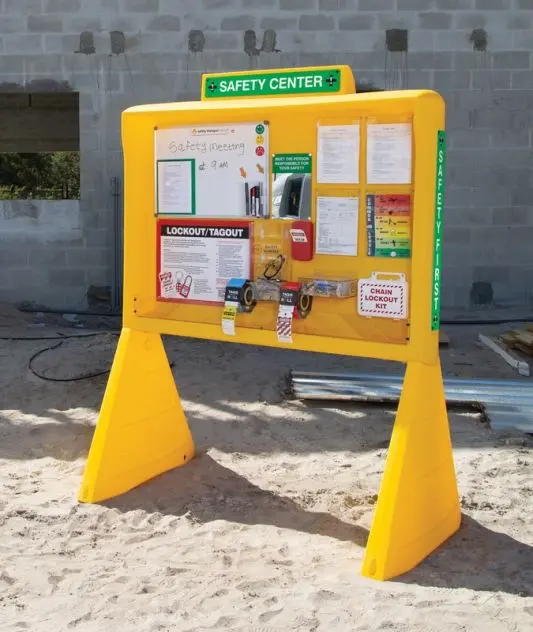
Over time, this emphasis on visibility and communication can lead to reduced incident rates, fewer regulatory violations, and improved safety performance across the organization.
6. Integration with Safety Programs
Site safety noticeboards are often integrated with broader safety management programs. For example, they may be used alongside safety training sessions, toolbox talks, and monthly audits to reinforce key messages. Digital advancements are also making it easier to connect physical boards with online safety platforms. Workers can scan QR codes to access additional resources, such as training videos or updated regulations, from their mobile devices.
This integration helps companies maintain a consistent and scalable approach to safety communication, supporting long-term compliance efforts and continuous improvement.
By serving as centralized compliance and communication solutions, site safety noticeboards enable companies to meet regulatory requirements, improve hazard management, and foster a safety-first culture.
Industry Applications of Safety Boards
Site safety noticeboards are essential across a wide range of industries, each with unique safety challenges and requirements. While the primary goal of these boards is consistent—ensuring worker safety and regulatory compliance—their design and content are often tailored to meet the specific needs of different sectors. Whether on a construction site, in a manufacturing plant, or in a corporate facility, these boards serve as vital tools for centralized communication and risk management.
1. Construction Industry
Construction sites are dynamic, high-risk environments where hazards constantly change due to shifting work zones, equipment use, and environmental conditions. In this industry, safety boards play a crucial role in communicating real-time updates and critical protocols to workers and contractors.
Construction sites typically display information such as:
- Evacuation routes and emergency procedures for incidents such as fires or structural collapses.
- Hazard warnings, including those for working at heights, excavation zones, and machinery use.
- Site contact information for safety officers and first responders.
Additionally, construction projects often require flexibility in safety communication due to the frequent relocation of work areas. RAMS Boards and other modular solutions allow for easy assembly, disassembly, and transportation, ensuring that safety information is always present where it’s needed most.
The use of custom layouts tailored to specific project phases also enhances safety. For example, hazard alerts might shift from structural instability to electrical safety concerns as different stages of the project progress. Site managers rely on noticeboards to keep all personnel aware of these evolving risks.
2. Manufacturing and Industrial Facilities
In manufacturing plants and industrial facilities, safety communication focuses heavily on equipment hazards, chemical safety, and process protocols. Noticeboards help workers stay informed about ongoing risks, inspection schedules, and emergency response procedures.
Key features of safety boards in these environments include:
- Equipment-specific protocols, such as lockout/tagout procedures to prevent machinery from being activated during maintenance.
- Hazardous material information, including safety data sheets (SDS) that outline handling, storage, and emergency response measures.
- Inspection logs for high-risk equipment, ensuring compliance with maintenance and safety standards.
Industrial facilities may also integrate safety boards with nearby first aid stations, fire extinguishers, and chemical spill kits. This strategic placement allows workers to quickly access both information and safety equipment in case of emergencies.
In environments where noise levels are high, visual communication becomes even more critical. Boards with large text, icons, and color-coded warnings help ensure that safety messages are understood despite auditory limitations.
3. Corporate Workplaces
While corporate offices may not face the same high-risk conditions as construction or manufacturing sites, safety compliance is still a legal and operational priority. Safety noticeboards in corporate environments typically focus on workplace health policies, emergency procedures, and building-specific hazards.
Common elements displayed on these boards include:
- Emergency evacuation plans, including routes to designated assembly points.
- Health and wellness initiatives, such as policies on ergonomics, fire drills, and mental health resources.
- Contact lists for security personnel, facility managers, and emergency medical responders.
Corporate offices also benefit from safety boards that incorporate digital components. For example, QR codes can link employees to electronic building maps or updates on fire alarm testing schedules. These features make it easier to disseminate important information across large office buildings where departments may have different safety needs.
4. Warehousing and Logistics
Warehousing and logistics operations present unique safety challenges related to material handling, heavy equipment, and vehicle movement. In these environments, safety boards serve as crucial points of communication to reduce risks associated with forklift operations, loading docks, and inventory storage.
Relevant safety information often includes:
- Traffic management plans that outline safe pedestrian and vehicle pathways.
- Material stacking and storage guidelines to prevent accidents from falling objects.
- Emergency response procedures for incidents like spills or injuries caused by heavy equipment.
Since warehouses can be fast-paced environments with high employee turnover, noticeboards provide consistent messaging to new hires, temporary staff, and subcontractors. This helps ensure that all personnel, regardless of experience, are aware of and adhere to safety protocols.
5. Healthcare and Laboratory Settings
Healthcare facilities and laboratories handle sensitive materials, hazardous chemicals, and specialized equipment. Safety communication in these settings is crucial for preventing both worker injuries and contamination risks.
Safety boards in these environments often feature:
- Biohazard warnings and chemical safety protocols.
- Infection control measures, including procedures for personal protective equipment (PPE).
- Emergency contacts for laboratory managers, chemical safety officers, and infection control specialists.
Because healthcare environments are highly regulated, maintaining updated safety information is essential. Noticeboards help institutions meet stringent compliance requirements by keeping critical safety documents readily available for inspections.
6. Mining and Remote Operations
In remote or isolated worksites like mines, safety communication must account for limited access to medical and emergency services. Safety boards in these environments are typically equipped with survival-critical information, such as:
- Emergency escape routes and mine safety protocols.
- Communications protocols for contacting external emergency services.
- Hazard identification for risks like cave-ins, gas leaks, and equipment malfunctions.
Given the remote nature of these operations, boards are often designed to withstand extreme environmental conditions, including high humidity, dust, and fluctuating temperatures.
Across all industries, site safety noticeboards play an indispensable role in improving communication, reducing risks, and ensuring compliance with both internal policies and regulatory standards.
Industry Applications of Safety Boards
Safety boards are essential tools across multiple industries, each of which faces unique risks and compliance requirements. While their core functions remain consistent—centralized communication, hazard awareness, and document organization—different sectors use safety boards to address their specific safety priorities. Construction, manufacturing, and corporate workplaces are some of the primary industries where safety boards have become indispensable.
1. Construction: Managing Dynamic Safety Zones
Construction sites are highly dynamic environments where risks change frequently due to shifting work zones, moving equipment, and fluctuating weather conditions. Safety boards play a critical role in helping site managers maintain compliance and reduce accidents by providing real-time information to workers.
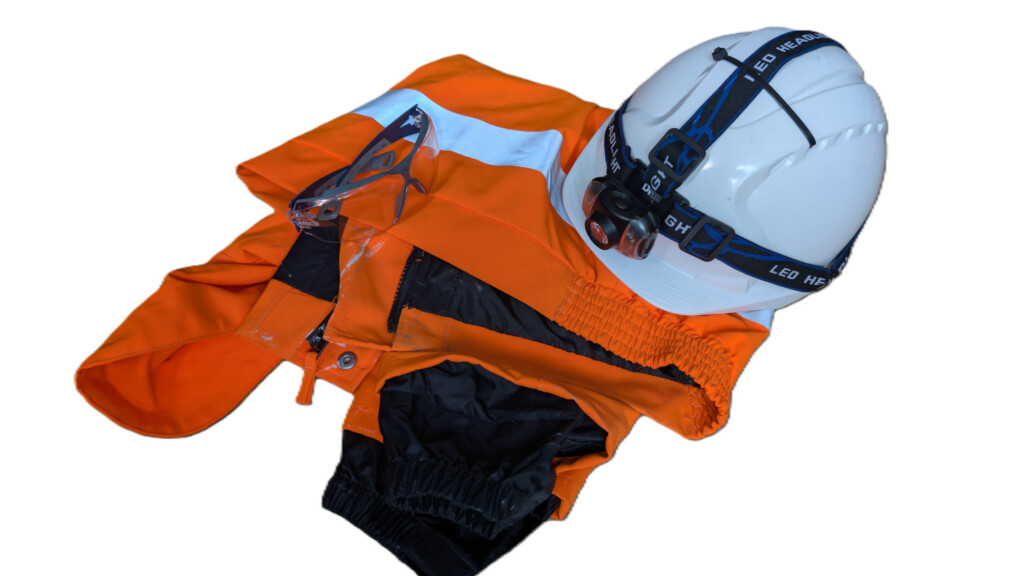
Boards on construction sites often display:
- Site Maps: Indicating access routes, restricted areas, and emergency exits.
- Daily Risk Assessments: Identifying new hazards as construction progresses, such as unstable structures or excavation areas.
- Personal Protective Equipment (PPE) Requirements: Reinforcing the need for safety gear like helmets, high-visibility clothing, and protective eyewear.
Additionally, these boards improve coordination among subcontractors and temporary staff by giving them quick access to essential safety information. Portable and weather-resistant options, such as RAMS Boards, are particularly valuable in construction, where safety boards may need to be relocated as work zones shift.
2. Manufacturing: Addressing Equipment Safety and Hazardous Materials
In manufacturing plants, safety communication focuses heavily on equipment operation, hazardous materials, and emergency response procedures. Equipment-related accidents, including machine malfunctions and improper handling, are common risks that require consistent monitoring and training.
Safety boards in manufacturing environments typically include:
- Machine Safety Instructions: Proper operating procedures, lockout/tagout protocols, and warnings related to specific equipment.
- Material Safety Data Sheets (MSDS): Detailed information on handling hazardous substances, including chemical storage and spill response procedures.
- Maintenance Schedules: Displaying inspection dates and required servicing for critical machinery to prevent breakdowns and accidents.
By integrating features like fire extinguisher holders and first aid kits, safety boards become multifunctional stations where workers can both access information and obtain emergency supplies. These features are crucial in high-risk operations where rapid responses can minimize injuries.
3. Corporate Workplaces: Ensuring Compliance and Safety Awareness
While corporate office environments are generally lower-risk compared to construction and manufacturing sites, they still have safety and compliance obligations. Emergency preparedness, fire safety, and ergonomic health are key concerns in these settings.
In corporate workplaces, safety boards are often used to:
- Display Emergency Evacuation Plans: Highlighting escape routes, assembly points, and the location of fire safety equipment.
- Promote Workplace Health Programs: Posting information on ergonomic guidelines, mental health resources, and wellness initiatives.
- Communicate Legal Notices: Displaying labor laws, health and safety regulations, and other mandatory notices required by government authorities.
These boards also serve a critical role during fire drills and other emergency preparedness exercises. By consolidating safety information in highly visible areas, corporate facilities can ensure that employees are aware of emergency protocols and workplace policies.
4. Infrastructure and Utilities: Managing Public and Worker Safety
In industries such as transportation, energy, and water utilities, both worker and public safety are top priorities. Infrastructure projects often span large areas and involve hazardous operations like heavy lifting, high-voltage work, or excavation near public spaces. Safety boards help these industries maintain control over safety risks by displaying important site-wide communication.
Common board features in these industries include:
- Hazard Zone Warnings: Notifying both workers and the public about restricted areas and active work zones.
- Permit Requirements: Information about access permits and authorization protocols for high-risk operations like confined space entry.
- Contact Information for Incident Reporting: Providing clear guidance on who to contact in the event of accidents or infrastructure failures.
Boards designed for outdoor utility work are often built with reinforced weather-resistant materials, ensuring durability in remote or exposed locations.
5. Healthcare and Laboratories: Communicating Biohazard and Emergency Procedures
In hospitals, laboratories, and research facilities, strict protocols are in place to prevent exposure to biological, chemical, and radioactive hazards. Safety boards are a key component of risk management in these environments, ensuring that both staff and visitors are aware of protocols for handling sensitive materials.
These boards may include:
- Biohazard Warnings: Indicating areas with restricted access due to contamination risks.
- Emergency Response Instructions: Steps for responding to chemical spills, biological exposure, or equipment failures.
- Personal Protective Equipment Guidelines: Ensuring that laboratory staff follow protocols for gloves, masks, and protective suits.
By organizing safety resources in one central location, safety boards reduce the likelihood of human error, which is critical in environments where mistakes can have serious consequences for health and safety.
6. Logistics and Warehousing: Managing Traffic and Load Safety
Logistics centers and warehouses handle large volumes of goods, often involving forklifts, conveyors, and heavy storage racks. Traffic management and load safety are top priorities in these fast-paced environments.
Key information displayed on safety boards includes:
- Traffic Routes and Forklift Safety: Designated pathways for forklifts and other vehicles to minimize collisions.
- Weight Limit Notices: Guidelines for safe stacking and storage of heavy materials.
- Emergency Contact Lists: Providing quick access to safety officers and first responders.
Effective communication through safety boards helps prevent accidents related to poor traffic control, unstable loads, and equipment misuse, ensuring smooth and secure warehouse operations.
Safety boards play a vital role across industries by addressing sector-specific risks and compliance needs. Customization options allow these boards to meet the exact requirements of each workplace, improving both worker safety and operational efficiency.
Practical Advantages of Modern Safety Boards
Modern safety boards, such as those provided by RAMS Boards and other industry leaders, offer numerous practical benefits that go beyond simple document display. They are designed to improve safety communication, support compliance, and streamline site operations. By leveraging durable materials, advanced features, and customizable layouts, these boards provide long-term value for construction, manufacturing, and other high-risk industries.
| Feature | Details |
|---|---|
| Durability and Weather Resistance | Traditional boards degrade under harsh weather, while HDPE boards maintain structural integrity. Protective pockets safeguard documents from water and dust. |
| Portability and Flexibility | Modern boards are modular and lightweight, easily relocated without specialized equipment. Supports can be filled for stability in windy areas. |
| Cost Savings Through Reusability | Reusable safety boards reduce replacement costs and support sustainability by minimizing waste. They are designed for multiple projects, lowering long-term maintenance expenses. |
| Enhanced Worker Engagement and Awareness | Organized layouts, visual aids, and motivational features (e.g., safety accountability mirrors) promote engagement with safety protocols and awareness of risks. |
| Integration with Safety Equipment | Boards often include built-in holders for fire extinguishers, eye wash stations, and first aid kits, improving emergency response times and accessibility. |
| Real-Time Updates for Dynamic Risk Management | Magnetic whiteboards and digital features enable site managers to provide real-time updates on hazards, weather, and access restrictions, ensuring proactive safety communication. |
By offering durability, portability, reusability, and real-time update capabilities, modern safety boards deliver significant practical advantages for site managers and EHS professionals. They support compliance, enhance worker engagement, and reduce operational costs, making them essential tools for maintaining high safety standards.
Daniel Chasen, Sub Agent at Jackson Civil Engineering Group Limited: “The RAMS board is working really well with most visitors commenting on it. The RAMS board works particularly well for us as our sites are quite mobile which means we can just relocated it with minimum fuss and it seems to be holding up well. Our previous timber made board did not fare so well.”
(Google reviews )Ugur Basar: “I highly recommend this company, a great product-outstanding build quality.”
Future Trends in Safety Communication
As workplace safety standards continue to evolve, industries are adopting innovative technologies and eco-friendly designs to enhance communication and compliance. Future trends in safety boards emphasize dynamic information delivery, digital integration, and sustainability, helping companies better manage risks and engage workers in safety protocols. For site managers and heads of safety, staying ahead of these developments can improve both operational efficiency and workforce protection.
1. Digital Integration and Smart Safety Boards
Technology is reshaping how safety information is delivered on worksites. Many modern safety boards are being designed with digital enhancements to provide workers with real-time updates and interactive access to safety resources. Digital integration can take various forms, including:
- QR Codes and NFC Tags: Workers can scan these codes with their smartphones to access digital versions of safety documents, such as risk assessments, safety data sheets (SDS), or training videos.
- Mobile Notifications: Integrated systems can push real-time alerts to workers’ devices, notifying them of new hazards, weather changes, or safety drills.
- Automated Safety Board Updates: In some advanced applications, digital screens on safety boards display automated updates from central management systems, reducing the need for manual changes.
These features enhance flexibility and ensure that safety information is always current, helping workers stay informed and compliant in dynamic environments.
2. Augmented Reality (AR) for Interactive Training
Augmented reality (AR) technology is emerging as a powerful tool for enhancing safety communication and training. AR applications can provide real-time, context-sensitive information by overlaying digital content onto a worker’s view of the physical environment through devices like smart glasses or mobile apps.
Examples of AR applications include:
- Visualizing Hazard Zones: Workers can see digital warnings highlighting dangerous areas, such as high-voltage zones or restricted access points.
- Interactive Safety Drills: AR simulations allow workers to practice emergency procedures in a controlled virtual environment, improving preparedness without disrupting site operations.
While still in its early stages, AR technology has the potential to revolutionize safety communication by making information more engaging and actionable.
3. Sustainability and Eco-Friendly Safety Boards
As companies strive to reduce their environmental impact, there is growing interest in sustainable safety infrastructure. Modern safety boards, such as those made by RAMS Boards, already use recycled materials like high-density polyethylene (HDPE), which offers both durability and eco-friendliness.
Future advancements may include:
- Carbon-Neutral Materials: Boards made from biodegradable or carbon-neutral materials that further reduce environmental impact.
- Sustainable Manufacturing Processes: Companies may prioritize suppliers that use renewable energy or recycled inputs in the production of safety boards.
- Reusable Components: Modular boards that can be easily reconfigured for new projects help minimize waste while maximizing their lifespan.
By adopting these eco-friendly innovations, companies can align their safety initiatives with broader sustainability goals, improving their reputation with stakeholders and clients.
4. Customization with Data-Driven Insights
The future of safety boards also involves greater customization based on data collected from workplace safety programs. By analyzing trends in incident reports, hazard assessments, and worker feedback, companies can tailor safety boards to address the most relevant risks on a given site.
This data-driven approach enables:
- Targeted Safety Messaging: Boards can prioritize specific types of information, such as common hazards or recurring compliance issues, to better address site-specific needs.
- Performance Monitoring: Integrated digital boards may track key performance indicators (KPIs) related to safety, such as the number of days without incidents, and display them to workers.
- Custom Alerts: Automated systems can generate customized alerts when certain safety thresholds are reached, such as exceeding acceptable noise levels or identifying equipment malfunctions.
5. Enhanced Worker Engagement and Behavioral Safety
Behavioral safety strategies are becoming increasingly important in efforts to reduce workplace accidents. These strategies focus on changing workers’ attitudes and behaviors through consistent communication and positive reinforcement. Modern safety boards are designed to support these efforts by using psychology-based elements, such as motivational messaging and visual cues.
Examples of engagement-focused features include:
- Personalized Safety Reminders: Mirrors with messages like “Meet the person responsible for your safety” prompt workers to reflect on their actions and take personal responsibility for safety.
- Recognition Programs: Digital safety boards may display worker achievements, such as safety milestones or participation in training programs, to foster a sense of accomplishment and teamwork.
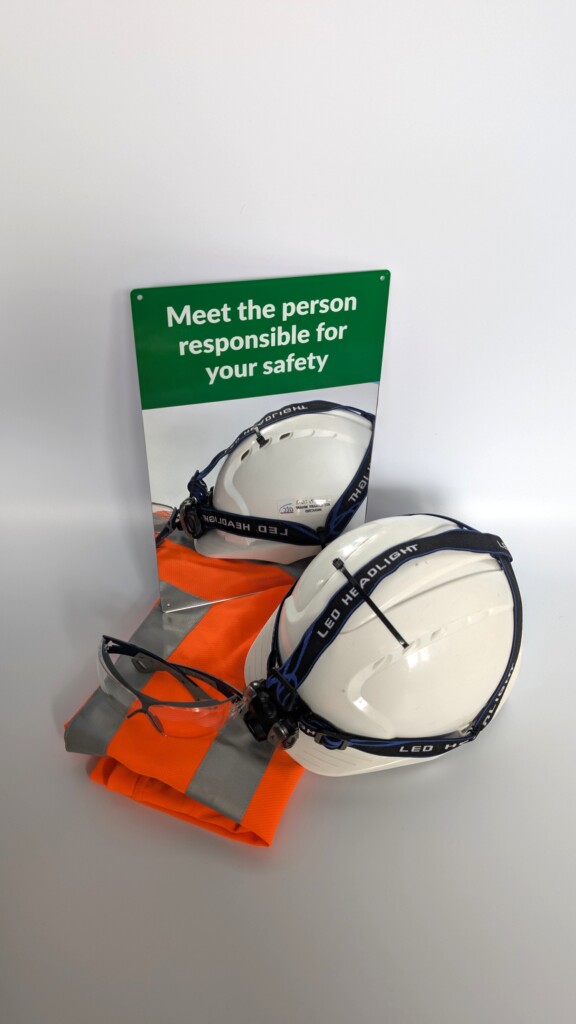
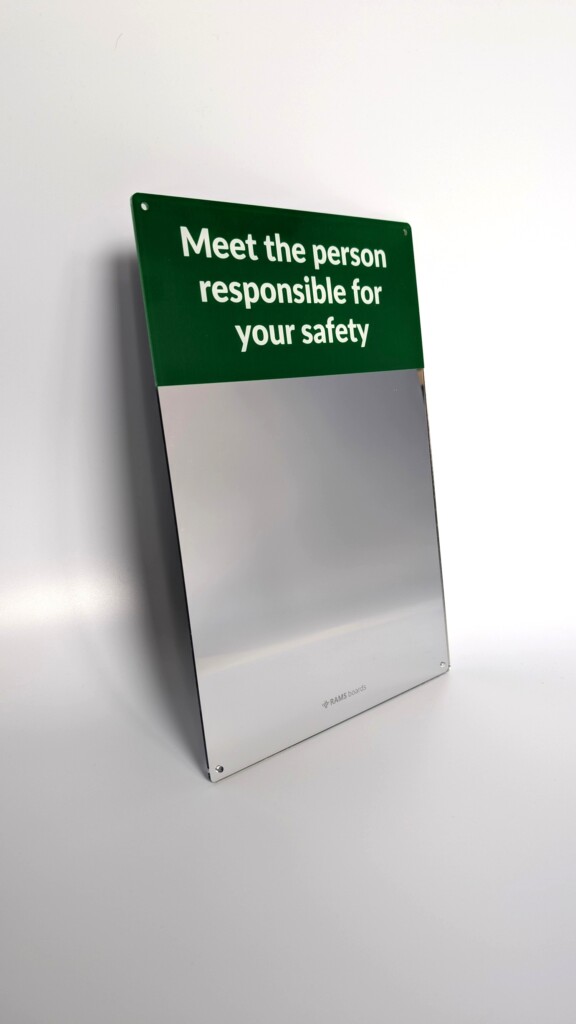
These techniques contribute to a stronger safety culture, where workers are actively involved in maintaining safe practices rather than simply complying with rules.
6. Integration with Workplace Management Systems
As companies adopt more comprehensive workplace management platforms, safety boards are becoming integrated with broader operational systems. This integration allows safety information to be synchronized across multiple locations and departments, ensuring consistency and scalability.
Key benefits include:
- Centralized Control: Site managers can update safety protocols across all sites from a single platform, reducing administrative workload.
- Incident Reporting: Workers can use QR codes on boards to quickly report hazards or incidents, streamlining the reporting process and improving response times.
- Data Analytics: Integrated systems provide insights into safety performance trends, helping organizations identify areas for improvement and implement corrective actions.
By embracing these future trends, companies can enhance their safety programs and adapt to the changing needs of their workforce and industry. Modern safety boards will continue to evolve, combining digital, physical, and psychological elements to provide comprehensive, real-time safety communication.
Elevating Safety Standards on Construction Sites
Safety communication is an essential component of workplace operations, particularly in high-risk industries such as construction and manufacturing. Effective communication tools, like modern project safety noticeboards, serve as critical infrastructure to keep workers informed, reduce accidents, and ensure compliance with health and safety regulations.
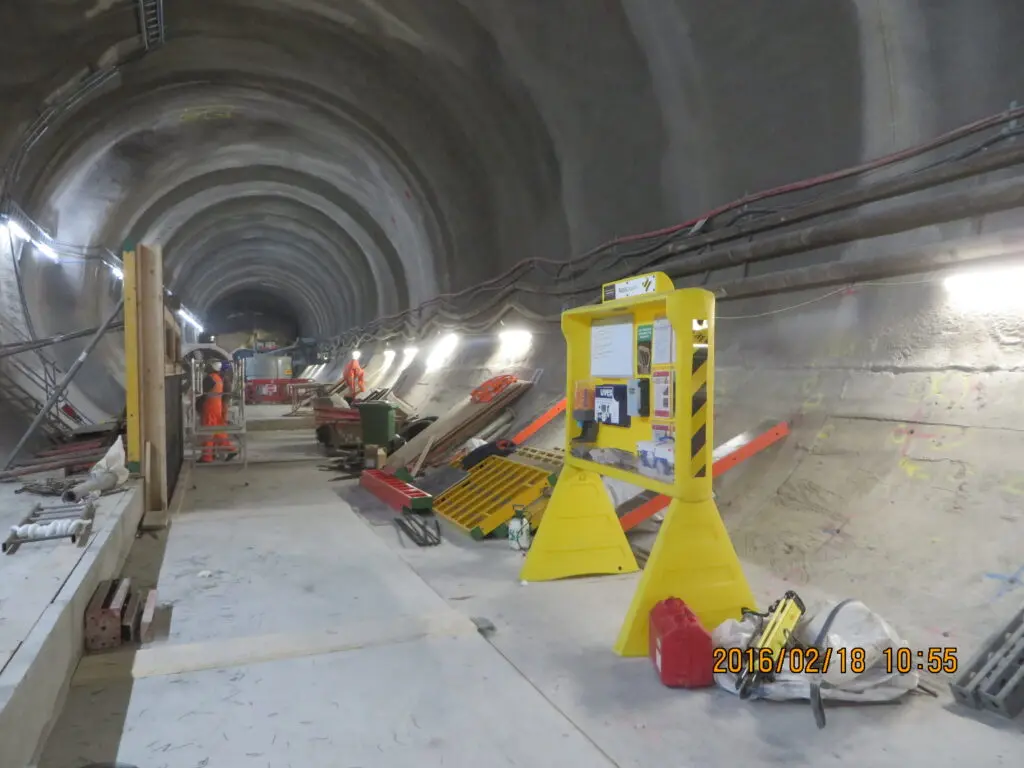
By organizing essential safety information in a centralized, highly visible format, these boards provide site managers and heads of safety with a practical and scalable solution to maintain high safety standards.
Recap of Key Benefits
Throughout this article, we’ve explored the various ways in which safety boards contribute to improved safety outcomes. Some of the most significant benefits include:
- Centralized Safety Communication
Safety boards consolidate critical information such as risk assessments, hazard warnings, and emergency procedures. This helps workers quickly find the resources they need, reducing confusion and improving emergency preparedness. - Customization and Industry Relevance
Boards can be tailored to meet the specific needs of various industries, whether that means displaying equipment safety instructions in manufacturing plants or evacuation plans on construction sites. Customization improves the relevance and engagement of safety communication for workers. - Regulatory Compliance
Maintaining compliance with health and safety standards is a major concern for all industries. Safety boards help companies fulfill legal obligations by clearly displaying required documents, inspection records, and emergency procedures. Well-organized boards also simplify inspections and audits, reducing the risk of penalties for non-compliance. - Durability and Long-Term Value
Made from weather-resistant materials like high-density polyethylene (HDPE), modern boards are built to withstand harsh environmental conditions. Their durability ensures that companies can use them across multiple projects, resulting in significant cost savings over time. - Worker Engagement and Behavioral Safety
Safety boards are designed to engage workers through clear visuals, motivational messages, and interactive features. This consistent communication reinforces a culture of safety, encouraging workers to take personal responsibility for their actions and adhere to protocols.
Call to Action for Construction Directors and Heads of Safety
In a competitive and safety-conscious industry, investing in modern safety infrastructure is no longer optional—it is a strategic necessity. Companies that prioritize safety communication not only reduce the likelihood of workplace incidents but also demonstrate their commitment to protecting employees and complying with regulations.
For construction directors and heads of safety, now is the time to evaluate your site’s safety communication practices. Ask yourself the following questions:
- Are your safety boards organized, legible, and accessible to all workers?
- Do your boards provide real-time updates to reflect changing site conditions?
- Are you meeting all regulatory requirements regarding the display of safety documents?
- Have you explored customization options to tailor your boards to your project’s needs?
If the answer to any of these questions is “no,” consider upgrading to modern safety boards that provide greater flexibility, durability, and functionality. Companies like RAMS Boards, SafetyBuyer, and First Safety Signs offer solutions designed to address these challenges and support safer, more efficient work environments.
What essential information should be displayed on a project safety noticeboard?
A project safety noticeboard should prominently feature: The Health and Safety Executive's (HSE) law poster, as required by the Health and Safety Information for Employees Regulations 1989. The company's health and safety policy, particularly the statement of intent outlining the organization's safety aims. Valid employer's liability insurance certificates. Names and contact details of appointed first aiders and fire marshals. Fire evacuation procedures, including escape routes and assembly points. Site maps indicating key locations such as welfare facilities, first aid stations, and emergency exits. Live permits for ongoing high-risk activities, ensuring all necessary safety checks are completed. These elements ensure compliance with legal requirements and promote a safe working environment.
Are there legal requirements for displaying specific documents on a safety noticeboard?
Yes, employers are legally obligated to display certain documents: The HSE's health and safety law poster or provide each worker with the equivalent leaflet. A written health and safety policy if the organization has five or more employees. A valid employer's liability insurance certificate. Additionally, for CDM (Construction Design and Management) notifiable projects, an F10 notification should be displayed.
How often should the information on a safety noticeboard be updated?
Information should be reviewed and updated regularly to ensure accuracy. Specific documents, such as insurance certificates and live permits, should be updated immediately upon renewal or change. Regular audits of the noticeboard can help maintain current and relevant information.
Can safety noticeboards be customized for specific project needs?
Yes, safety noticeboards can and should be tailored to meet the specific requirements of a project or site. Customization may include: Including site-specific emergency procedures and contact information. Displaying relevant permits and safety data sheets for hazardous materials used on-site. Incorporating company branding and motivational safety messages to enhance engagement. This customization ensures that the information is relevant and effectively communicated to the workforce.
How can I ensure that the safety noticeboard effectively engages employees?
To enhance employee engagement: Keep the noticeboard organized and uncluttered, focusing on essential and current information. Use clear headings, bullet points, and visuals to make information easily digestible. Regularly update content to keep it fresh and relevant. Incorporate interactive elements or digital displays to capture attention. Solicit feedback from employees on the noticeboard's content and layout to make continuous improvements. An engaging noticeboard fosters a culture of safety and encourages employees to stay informed.
Where should a safety noticeboard be located on-site?
The noticeboard should be placed in a prominent, accessible location where all employees can easily view it. Common areas include: Near main entrances or exits. In break rooms or common areas. Adjacent to time clocks or attendance stations. The chosen location should be well-lit and free from obstructions to ensure visibility. Positioning the noticeboard in high-traffic areas increases the likelihood that employees will regularly consult it.
